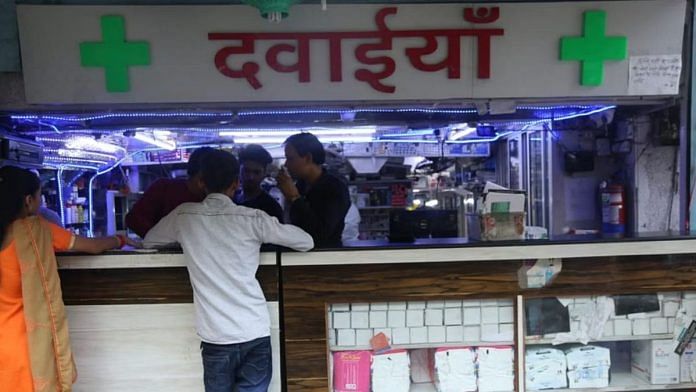New Delhi: There is no plan to ban the manufacture and sale of ranitidine despite concerns over N-nitrosodimethylamine (NDMA), an impurity in the drug which has been found to degrade into a probable carcinogen, the government informed the Parliament Tuesday.
“At present, there is no proposal to prohibit the manufacture, distribution, and sale of ranitidine in the country,” it said in response to an unstarred question.
Launched for the first time in 1981 by British pharmaceutical giant GSK’s forerunner Glaxo, ranitidine is sold and consumed as a popular heartburn medicine under names such as Rantac, Aciloc, and Zinetac in India.
The drug is, however, banned or suspended in the United States, Europe, and Australia among several other countries, leading to demands, from time to time, for India to follow suit.
In 2019, scientific evidence first emerged that ranitidine—used mainly to treat peptic ulcers, gastroesophageal reflux disease (GERD), heartburn, and indigestion—degraded over time to form a probable carcinogenic compound, NDMA.
Following an alert by the US Food and Drug Administration (FDA), many medical regulators in other countries banned the drug the same year.
In 2020, the USFDA ordered a national withdrawal of all brands of this medicine, triggering a wave of lawsuits against several pharmaceutical firms, including Pfizer, Boehringer Ingelheim, and Sanofi, apart from GSK, which had been marketing the drug.
Also Read: Cipla set to bring Afrezza, 1st inhalable insulin since Exubera, to Indian markets by 2025
‘Cheap & effective medication’
Responding to a query by Trinamool Congress MP Mohammed Nadimul Haque, Union Minister of State for Health and Family Welfare Anupriya Patel said in a written reply that the Central Drugs Standard Control Organisation (CDSCO) has taken various actions to ensure patient safety, including testing of ranitidine samples for the impurity.
Haque had asked the government whether it has has reviewed the findings of international regulatory bodies, such as the USFDA and European Medicines Agency (EMA), on the presence of NDMA in ranitidine and its health implications.
State drugs controllers, too, have been asked to instruct the manufacturer of the active pharmaceutical ingredient and formulations of ranitidine to verify and test their products and take appropriate measures to ensure patient safety, said the reply.
Additionally, the minister said, the CDSCO had also instructed zonal offices to draw samples to test the level of NDMA impurity in ranitidine.
The government said that a chapter in the 9th edition of the Indian Pharmacopoeia (IP) 2022, published by the Indian Pharmacopoeia Commission, provides the methods of analysis of the nitrosamine impurities, including the NDMA, along with their acceptable intake limits. Ranitidine is supposed to contain only the acceptable limit of NDMA as mentioned in the IP 2022.
Some clinicians, meanwhile, pointed out that ranitidine has been a cheap and effective medication for acidity and ulcer disease for over four decades and has consistently featured on the World Health Organisation (WHO)’s List of Essential Medicines due to its efficacy, safety profile, and affordability, particularly when compared to proton pump inhibitors (PPIs)—a group of drugs that reduce stomach acid production.
Dr Rajeev Jayadevan, gastroenterologist and medical researcher, said, “Many patients who use ranitidine report no side effects, and doctors with decades of experience consider it both safe and reliable.”
NDMA scare
According to pharmacologists, NDMA—a volatile chemical belonging to the nitrosamine class of compounds—is a by-product of manufacturing processes involving alkylamines.
Humans can be exposed to it through tobacco smoke and even food items, especially nitrite-preserved foods such as cured meats. It can also form in the stomach endogenously during digestion of alkylamine-containing foods (such as tea, wine or apples) at very low levels.
The WHO’s International Agency for Research on Cancer (WHO-IARC) classifies NDMA as a group 2A carcinogen, which means it’s “probably carcinogenic to humans”.
Jayadevan underlined that, while concerns have been raised over the detection of NDMA in some ranitidine samples, the classification of the molecule does not imply that as a probable carcinogen, it will definitely cause cancer.
“To provide context, common exposures such as high-temperature frying and night shift work are also categorised as group 2A carcinogen,” he said.
Although the technical discussion on NDMA has sparked “disproportionate” fear among some individuals, large studies have found no increase in cancer risk among people who used ranitidine compared to those who did not, Jayadevan also stressed.
NDMA production process unclear
A senior pharmacologist who has been attached to a scientific committee under CDSCO which deliberated on ranitidine in the past, told ThePrint that NDMA is formed in ranitidine API (Active Pharmaceutical Ingredient) because of an intermolecular degradation reaction between ranitidine molecules that occurs primarily in a solid state even though the exact reaction mechanism is unknown.
In 2019, after an alert by the USFDA, drug regulators in some countries concluded that the ranitidine molecule itself was capable of generating NDMA while some others linked it to API impurities, said the pharmacologist who did not want to be named.
He also said that there is very limited evidence from clinical practice linking ranitidine with cancer in its users even though the drug has been used widely for over 4 decades.
‘For this reason, the CDSCO felt that there was no conclusive evidence to ban the drug in India,” he said.
In 2022, however, the Union Ministry of Health dropped ranitidine from the National List of Essential Medicines (NELM). This list includes drugs used in treating diseases considered wide public health concerns. These medicines are procured for various government health programmes while the government also directly controls their ceiling prices.
Jayadevan underlined that from India’s standpoint, the low cost and long-established safety record of ranitidine make it a valuable option for patients.
(Edited by Sanya Mathur)
Also Read: Swapping ghar ka khaana with ready-to-eat foods? 66% beverages have high sugar, 97% snacks high fat






